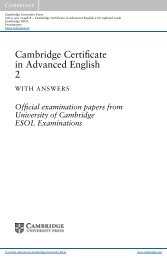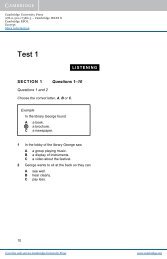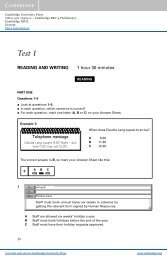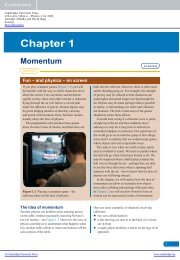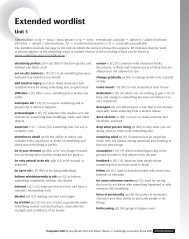Skills for Study Level 2 Teacher's Book - Cambridge University Press
Skills for Study Level 2 Teacher's Book - Cambridge University Press
Skills for Study Level 2 Teacher's Book - Cambridge University Press
You also want an ePaper? Increase the reach of your titles
YUMPU automatically turns print PDFs into web optimized ePapers that Google loves.
3dAnswersThe correct readings are:Full-timePart-timeMale 40.1 17.6Female 37.4 18.43e Note: In this activity, students are presented with a picture graphic of the sort oftenseen in newspapers, where a change in numbers is represented by two identicalpictures of different sizes. These are potential distortions of the data they represent,because the relative sizes of the two images often have no relation to the change inmagnitude that they are supposed to represent. (It is possible to make a relativelysmall increase appear ‘massive’ simply by placing a disproportionately large picturenext to a smaller one.)Suggested answers1 The proportion of female students studying science dropped between 1998and 2005, but only by 1.1%. The difference in the sizes of the two womenseems to imply a much bigger decrease.2 No: in order <strong>for</strong> it to be accurate, the second image of the woman wouldhave to be 1.1% smaller than the first one. The difference here is muchgreater than 1.1%.3 This could be used to give the impression that the decrease was muchgreater than it actually is.4 As the in<strong>for</strong>mation being presented is so basic (only two percentage figures),you could reasonably say that it is a waste of space to put it in a graphic atall – it could be mentioned simply in one sentence of text.3fSuggested answers1 The graph seems to suggest that there is a rapid increase in the percentageof women in the work<strong>for</strong>ce.2 Students can be left to suggest their own ideas. They may notice the problemwith the time intervals, or perhaps will not notice and try to imagine otherreal-world reasons to explain the increase.3 The x-axis does not show equal intervals of time – it is year by year until thevery end, when there is an 18-year gap between 1990 and 2008.4 This gives the impression of a sudden jump in figures. If the 18 years wererepresented with yearly intervals, the increase would be much more gradual.The in<strong>for</strong>mation might have been presented in this way to emphasize theincrease.Unit 1 Part B ∙ Understanding written in<strong>for</strong>mation 18



